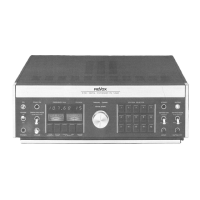Fig.
4.3.-1
Bei Mess-Sendern, deren
Signalspan-
nungen
fur den
Nenn-Abschluss-Widerstand
ge-
eicht sind, ist
der halbe Wert der angegebenen
EM
K
einzustellen.
Die vorherrschende Mess-Frequenz von
97
MFIz gilt als Richtwert. Vor
dem Abgleich ist
zu
prufen,
ob
diese Frequenz frei
von Sender-
einfal! Oder
I
nterferenzen ist (bei
angeschlos-
senem,
jedoch abgeschaltetem Mess-Sender).
Ist
diese Frequenz 97 MHz nicht frei, so ist
die Ein-
stellung leicht zu verandern.
Alie Messungen
erfolgen
gegen Masse!
Bevor
mit dem Abgleich
begonnen
wird,
mussen
die
Speisespannungen
unbedingt
kontrolliert
und
notigen
falls einjustiert
warden.
Mit den
Abgleicharbeiten erst beginnen, wenn
der Mess-Sender die stabile
Messfrequenz
er-
reicht
hat (Thermodrift).
When working with RF-generators
whose
output
calibration is already taking into
account the nominal load impedance of the
equipment under test, the generator's output
has to
be
set to one half of the specified open
circuit voltage.
The
predominantly used test frequency
of 97
MHz is to be taken as an approximate
value only. Prior to starting any
alignment pro-
cedures one should
make sure
that this fre-
quency does not produce an interference with
a
neighbouring
FM-transmitter.
(To
check this,
have the test generator connected
to
the tuner
but
with
the RF-signal turned off.) If an FM-
broadcast can
still be received, the test fre-
quency should be
altered to
an
adjacent
channel.
AH
measurements are taken with reference to
chassis.
Before starting any
alignment procedures, check
all supply voltages and,
if necessary,
adjust
them
to
their nominal values.
Allow a sufficient
warm-up period
for the test
equipment to ensure stable
frequency condi-
tions
(thermal drift) before
commencing any
alignment.
Pour
que
les tensions soient
adaptees
a
la resistance terminale, reglez
le
generateur HF
a
la moitie de la valeur f.e.m. donnee.
La
frequence de mesure principale
est
de
97
MHz. S'assurer avant
de
commencer les re-
glages,
que cette frequence
soit exempte
d'emission ou d'interference (ne raccordez
le
generateur
que
declenche). Si
cette
frequence de
97
MHz
n'est pas libre, decalez
legerement
I'accord.
Toutes les mesures sont referees en masse.
Avant de
commencer les
regfages, H est in-
dispensable
de
verifier
toutes les
tensions d'ali-
mentation et de les corriger si necessaire.
S'assurer egalement de la
stab
Hite
thermique du
generateur etalonne
(thermodrift).
4.3,
Kontrolle der
Speisespannungen
4.3.
Checking the
supply voltages 4.3. Verification
des
tensions d'alimentation
Gerat
einschalten.
Netzspannung
mit Regeltrafo
genau
auf Nennspannung
einstellen.
Stromauf-
nahme
bei 220 V: <
0,2
A.
Spannungsmessun-
gen
an der Verteilerplatine
(Fig.
4.3.—
1
):
With the tuner
switched on the electric current
consumption
at
220
V should be:
<0.2
A. Use
a
variable voltage
transformer if
the supply
volt-
age deviates from its
nominal value. Check the
voltages on the distribution
board
(4.3.—
1
).
Enclenchez
I'appareil. A I'aide
d'un variac,
ajustez
la tension secteur
a
la tension
nominale.
Consommation
a
220 V;
0,2
A.
Mesurez les
tensions
sur la plaquette
de
distribution
(fig.
4.3.-1):
+
22
V
-22
V
±
0,8
V unstabilisiert
+
22
V
-22
V
+
0.8 V unstabilized
+
22
V
-22
V
±
0,8
V non stabilise
+
15
V
-15
V
±
0,5
V stabilisiert
+
15 V
-15
V
±
0.5
V stabilized
+
15
V
-15
V
±
0,5
V stabilise
+
6 V
±
0,3
V stabilisiert
+
6 V
+
0.3 V
stabilized
+
6
V
±
0,3
V stabilise
+
32
V
±
0,5
V
stabilisiert,
einstellbar
+
32
V
±
0.5 V stabilized, adjustable
+
32 V
±
0,5
V stabilise, reglable
+
5,6
V
±
0,3 V
stabilisiert
5.6 V
+
0.3 V
stabilized
+
5,6
V
+
0,3
V
stabilise
4-2

